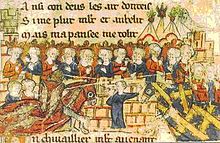
The Tournament of Chauvency was held in 1285 to bring together the greatest knights of France and Germany for six days of jousting and other activities, a social event of primary importance at the end of the thirteenth century. Dedicated to Henry IV, Count of Salm, the tournament was organized by Louis V, Count of Chiny, and held in the small village of Chauvency-le-Château, near Montmédy.
The tournament was documented in the poem le Tournoi de Chauvency by the thirteenth century trouvère Jacques Bretel. The miniatures of the Oxford manuscript show knights struggling during the jousting and other activities of the tournament.
Nearly 500 knights and other royalty and their wives participated in the tournament. Most notable are:
- Rudolf I, King of Germany
- Ottokar II, King of Bohemia (see below)
- Frederick III, Duke of Lorraine
- John I, Duke of Brabant [ citation needed ]
- Jean de Faucogney, viscount of Vesoul
- Theobald II, Count of Bar
- Henry III, Count of Bar, son of the previous
- John of Bar, brother of the previous
- Louis V, Count of Chiny
- Jeanne de Bar, wife of the previous
- Gerard de Looz, Seigneur de Chauvency le-Château, brother of Louis V
- Henry V the Blond, Count of Luxembourg
- Margaret of Bar, wife of the previous
- Henry VI the Condemned, Count of Luxembourg
- Béatrice d'Avesnes, wife of Henry VI of Luxembourg
- Waleran I, Lord of Ligny
- Thomas of Blankenberg, step-son of Louis V (son of Jeanne of Bar and her first husband Frederick de Blâmont)
- Guy of Dampierre, Count of Flanders
- Philip of Chieti, youngest child of Guy
- John I, Count of Hainaut
- John II, Count of Holland, son of John I
- Florent of Hainaut
- Renaud I, Count of Dammartin.
Note that Ottokar II was killed on 26 August 1278 at the Battle on the Marchfeld (by the troops of Rudolf) as so was clearly not at the tournament as reported by Bretel.
A fanciful description of the tournament activities can be found in the book The Reign of Chivalry by British historian Richard Barber. [1]
According to Laret-Kayser, [2] Louis V used to tournament to promote his family's illustrious history, from being descended from Charlemagne to his ancestor Arnold I, Count of Chiny, sending his sons to fight in the First Crusade.